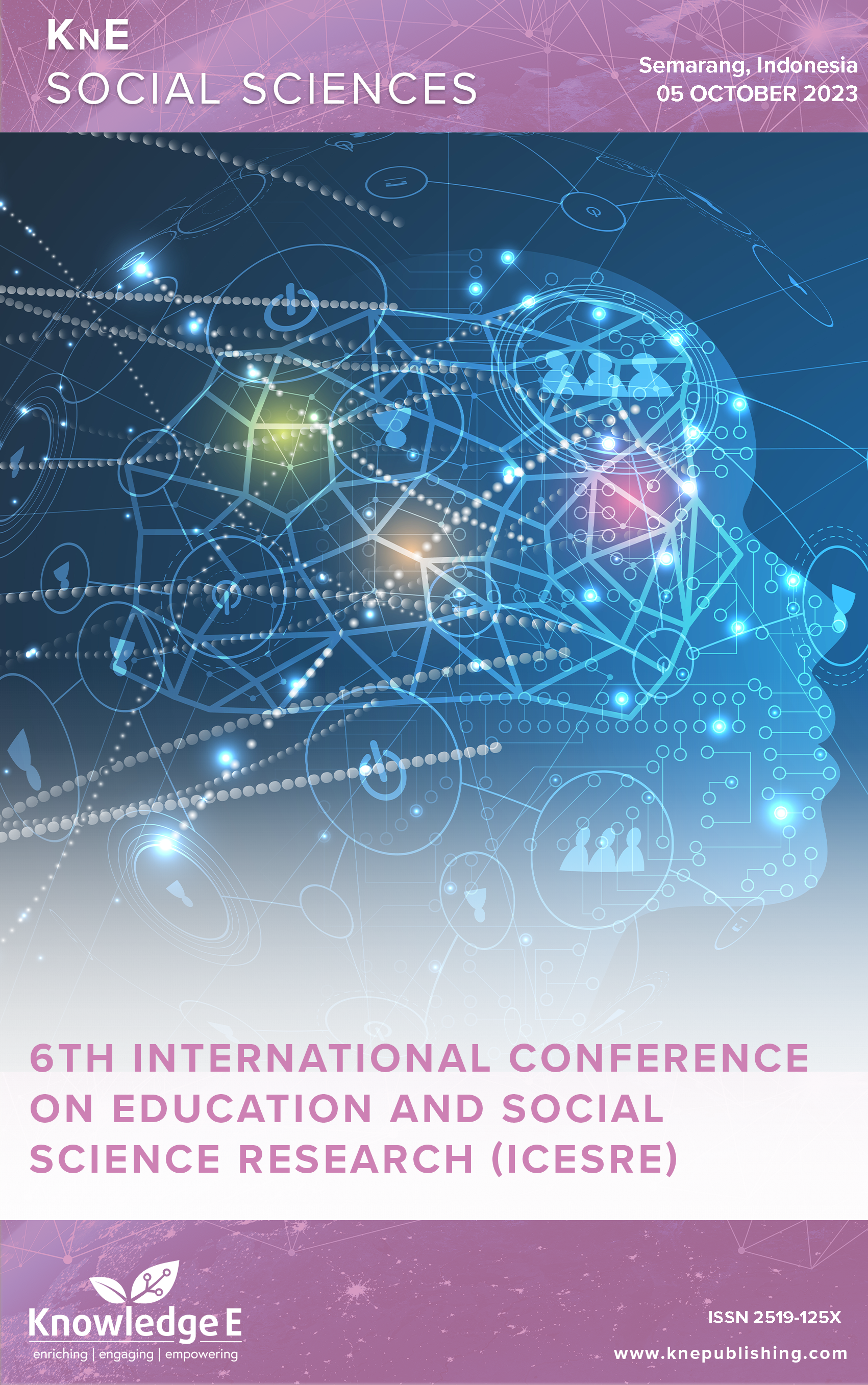Effect of Digitalization of Web-Based Science Learning Media with the STEAM Approach to Student's Creative Thinking Abilities
DOI:
https://doi.org/10.18502/kss.v9i6.15259Abstract
Learning innovation in the present digital transformation era emphasizes employing technology and methods in learning. The utilization aims to enhance 21st-century foundational skills, including students’ abilities in creative thinking. This research was conducted with the purpose of investigating how the application of web-based science learning media with the Science, Technology, Engineering, Mathematics, and Arts (STEAM) approach improves student’s creative thinking abilities. This research process uses a quasi-experimental research design using a one-group pretest-posttest design. The sample of this research consisted of 7th-grade students at SMP Negeri 65 Central Maluku. The results showed that website for science learning media with the STEAM approach had a significant impact on student’s creative thinking abilities with very creative indicators of 18.75%, creative 75%, and creative enough of 6.25% with an N-Gain Test score of 0.61 in the medium category and by results of data analysis of the t-test with a significance value (2-tailed) 0.000 < 0.05. based on research results, using web-based science learning media with the STEAM approach can potentially increase student’s ability to think creatively by integrating the media flow of science, technology, engineering, art, and mathematics. With this media, teachers can train students to produce innovative solutions and creative thinking skills and support digital transformation.
Keywords: STEAM, media, creative thinking, web-based learning
References
Juniarso T. Model Discovery Learning Terhadap Kemampuan Berpikir Kreatif Mahasiswa. ELSE (Elementary School Education Journal). Jurnal Pendidikan Dan Pembelajaran Sekolah Dasar. 2020;4(1):36. DOI: https://doi.org/10.30651/else.v4i1.4197
Kamid K, Sayiful S, Ramalisa Y, Sufri S, Triani E. Comparison and Correlation between Attitude and Process Skills in Mathematics: The Case of Public and Islamic Middle Schools in Indonesia. Jurnal Pendidikan Progresif. 2022;12(2):511–28. DOI: https://doi.org/10.23960/jpp.v12.i2.202210
Ulandari N, Putri R, Ningsih F, Putra A. Efektivitas Model Pembelajaran Inquiry terhadap Kemampuan Berpikir Kreatif Siswa pada Materi Teorema Pythagoras. Jurnal Cendekia : Jurnal Pendidikan Matematika. 2019;3(2):227–37. DOI: https://doi.org/10.31004/cendekia.v3i2.99
Thana PM, Hanipah S. Kurikulum Merdeka: Transformasi Pendidikan SD Untuk Menghadapi Tantangan Abad ke-21. Prosiding Konferensi Ilmiah Dasar; 2023. pp. 281–8.
Widodi B. Darmaji, Astalini. Identifikasi Keterampilan Proses Sains dan Kemampuan Berpikir Kreatif Siswa. Jurnal Pendidikan Dan Pembelajaran IPA Indonesia. 2023;13:1–8. DOI: https://doi.org/10.23887/jppii.v13i1.57131
Munandar U. Pengembangan Kreativitas Anak Berbakat. 3rd ed. Rineka Cipta; 2014.
Bahtiar B, Dukomalamo N. Basic science process skills of biology laboratory practice: improving through discovery learning. Biosfer. 2019;12(1):83–93. DOI: https://doi.org/10.21009/biosferjpb.v12n1.83-93
Asivah ND, Wulandari FE. Creative Thinking Skills of Students on Environmental Pollution Theory at Muhammadiyah School. Academia Open. 2020;3: https://doi.org/10.21070/acopen.3.2020.504. DOI: https://doi.org/10.21070/acopen.3.2020.504
Leasa M, Batlolona JR, Talakua M. Elementary Students’ Creative Thinking Skills in Science in The Maluku Islands, Indonesia. Creativity Studies. 2021;14(1):74–89. DOI: https://doi.org/10.3846/cs.2021.11244
Mulder WR, Siswanto J. Analisis Kemampuan Berpikir Kreatif Siswa Kelas VII Smp Negeri 65 Maluku Tengah pada Materi Suhu Dan Kalor. Jurnal Inovasi Penelitian Dan Pembelajaran Fisika. 2023;4(1):1. DOI: https://doi.org/10.26418/jippf.v4i1.56629
Talakua C, Sesca Elly S. Pengaruh Penggunaan Media Pembelajaran Biologi Berbasis Mobile Learning terhadap Minat dan Kemampuan Berpikir Kreatif Siswa SMA Kota Masohi. BIODIK. 2020;6(1):46–57. DOI: https://doi.org/10.22437/bio.v6i1.8061
Arisanti DA. Analisis Kurikulum Merdeka dan Platform Merdeka Belajar untuk Mewujudkan Pendidikan yang Berkualitas. Jurnal Penjaminan Mutu. 2022;8(2):243– 50. DOI: https://doi.org/10.25078/jpm.v8i02.1386
Mufida SN, Sigit DV, Ristanto RH. Integrated project-based e-learning with science, technology, engineering, arts, and mathematics (PjBeL-STEAM): its effect on science process skills. Biosfer. 2020;13(2):183–200. DOI: https://doi.org/10.21009/biosferjpb.v13n2.183-200
Rofiqoh IF, Subiki S, Budiarso AS. Identifikasi Kemampuan Berpikir Kreatif Siswa dengan Metode Mind Mapping pada Pembelajaran Fisika Pokok Bahasan Optik di SMA. Jurnal Pembelajaran Fisika. 2020;9(4):139. DOI: https://doi.org/10.19184/jpf.v9i4.18359
Sari PK, Sutihat S. Sutihat. Pengembangan E-Modul Berbasis STEAM untuk MeningkatkanKemampuan Berpikir Tingkat Tinggi pada Pembelajaran Tematik di Sekolah Dasar. Jurnal Pendidikan Sains Indonesia. 2022;10(3):509–26. DOI: https://doi.org/10.24815/jpsi.v10i3.24789
Belazoui A, Telli A, Arar C. Web-Based Learning Under Tacit Mining of Various Data Sources [IJET]. Int J Emerg Technol Learn. 2021;16(16):153. DOI: https://doi.org/10.3991/ijet.v16i16.23405
Li H. A Multirate Cognitive-Based Approach for Optimal Dynamic Allocation of English Online Teaching Resources and IoT Applications. Wirel Commun Mob Comput. 2022;2022:1–10. DOI: https://doi.org/10.1155/2022/6447684
Meri-Yilan S. Learning in scaffolded autonomous e-learning environments amongst EAP students in a UK university. Focus on ELT Journal; 2019. https://doi.org/10.14744/felt.2019.00002. DOI: https://doi.org/10.14744/felt.2019.00002
Silva DE S. Sobrinho MC, Valentim N. STEAM and Digital Storytelling: a case study with high school students in the context of Education 4.0. Anais do XXX Simpósio Brasileiro de Informática na Educação (SBIE 2019), Brazilian Computer Society. Sociedade Brasileira de Computação - SBC; 2019. p. 159. DOI: https://doi.org/10.5753/cbie.sbie.2019.159
Wannapiroon N, Petsangsri S. Effects of STEAMification Model in Flipped Classroom Learning Environment on Creative Thinking and Creative Innovation. TEM Journal 2020:1647–55. https://doi.org/https://doi.org/10.18421/TEM94-42. DOI: https://doi.org/10.18421/TEM94-42
Habibi MA. Effect of the STEAM Method on Children’s Creativity. Jurnal Penelitian Pendidikan IPA. 2023;9(1):315–21. DOI: https://doi.org/10.29303/jppipa.v9i1.2378

